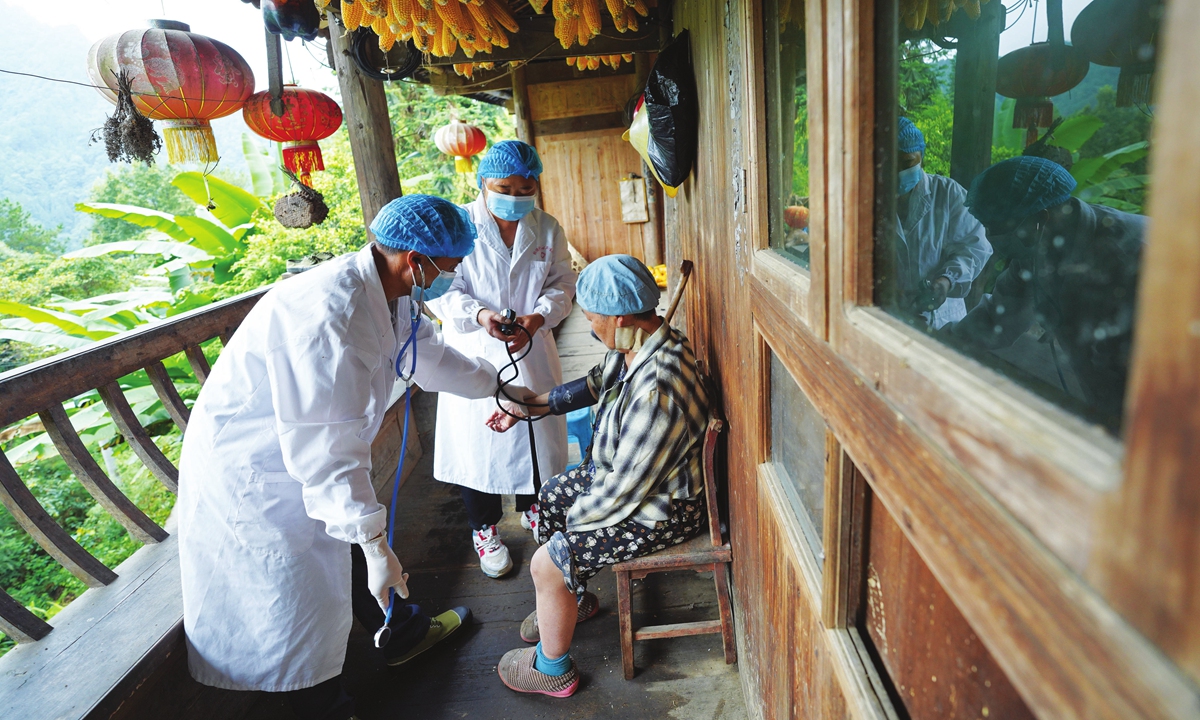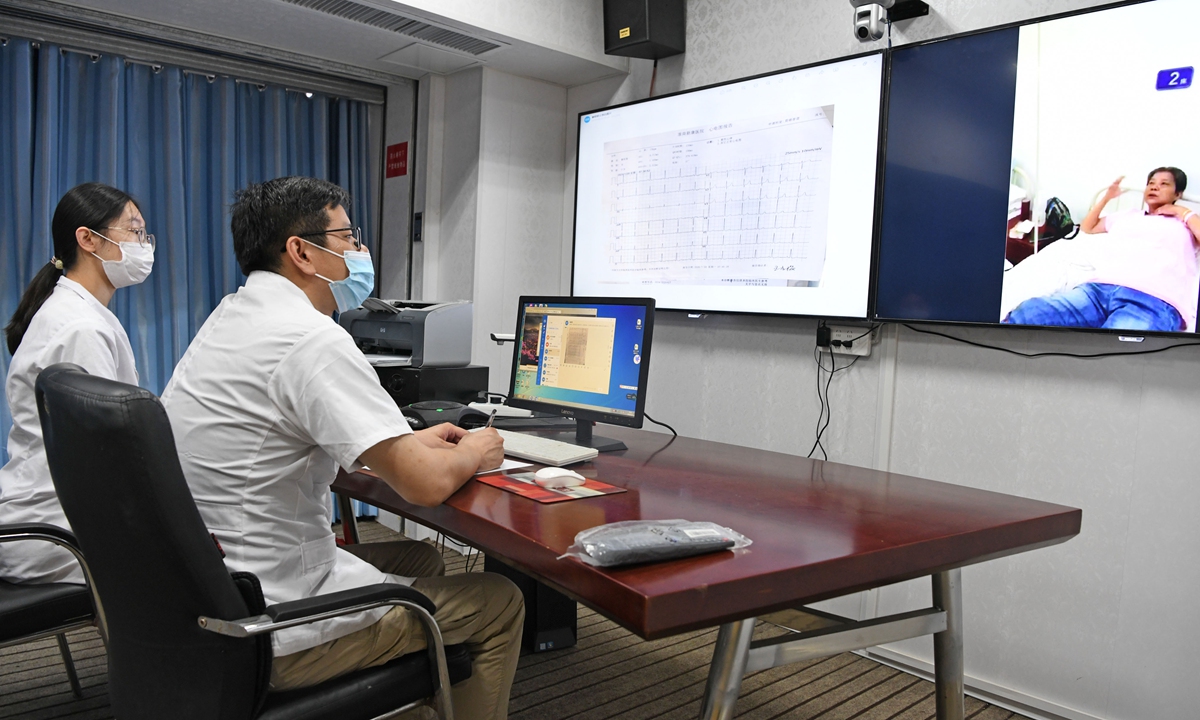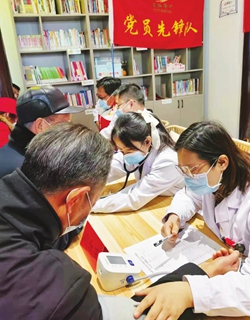Healthier, long lived population a sign of CPC’s dedicated commitment to safeguarding people’s health
Editor's Note:
Who is the Communist Party of China (CPC)? What is the CPC's role in the new era?
The CPC has grown into one of the largest ruling parties in the world in the process of leading Chinese people in seeking liberation and happiness, making China as strong and prosperous as it is today.
As the CPC ushers the nation into a new era of development, the last decade has witnessed great achievements in national strength and prosperity, with people's confidence and recognition of this path rising to unprecedentedly high levels.
With more than 96 million members, the CPC will convene its 20th National Congress in the second half of the year, which is expected to guide the country's development and policymaking. Ahead of the meeting, the Global Times is publishing a series of stories to help the world understand the CPC in the new era, through the stories of CPC members working on the frontlines of various fields, as well as through observations made by respected scholars
In this installment, we see an illustration of the CPC's protection of most basic human rights and people's well-being through learning about the medical services and the meticulous care of the elderly and women in China's most famous areas full of longevity.

China's health authorities ramped up efforts to raise the capacities of family doctors and streamline their services. A guideline jointly issued by six governmental departments, including the National Health Commission, in March suggested that China will expand family doctor services to cover at least 75 percent of its population, and about 85 percent of priority patients such as the elderly, expectant mothers, children, and people living with disabilities, by 2035.
The government will work to raise the percentage of people registered with family doctors by 1-3 percentage points every year as from 2022, it said.
Moreover, China has expanded medical facilities in rural areas in the last decade to ensure its 509.8 million rural residents have access to basic medical services.
By the end of 2021, China had set up 23,000 county-level medical and healthcare institutions, 35,000 township health facilities, and 599,000 village clinics across the country, the National Health Commission told a press conference in May.
The establishment of health agencies has remedied the shortfall in medical resources in rural regions and enabled rural residents, or 36.1 percent of the total population, to enjoy medical services at their doorsteps, the commission said.
Magic of world's longevity township
The growing aging population and a falling birth rate have once again highlighted the issues such as old-age care. The city of Rugao is one of the most famous areas in China for longevity. There were currently 525 centenarians among the local population of 14 million people, which far exceeds the longevity standard prescribed by the United Nations and ranked top across China.
Over the last decade, to implement the national strategy of actively coping with an aging population, Rugao has accelerated the construction of a high-quality medical service system for the elderly, such as using "internet plus" to build a family physician contract service platform, and strengthen the publicity and promotion of this service, Wu Haiyan, deputy party secretary of the Rugao Health Commission, told the Global Times.
Rugao is currently promoting the deep integration of health resources and pension institutions, focusing on supporting the development of nursing institutions for the elderly, and actively promoting the integrated development of medical treatment and rehabilitation.
The local government needs to establish infirmaries or special geriatric rehabilitation hospitals in nursing homes with more than 100 beds, and relevant services will be covered by the public medical insurance, the Global Times learnt from local authority.

As the aging population grows, Rugao is easing the medical staff shortage at the community level. The problems of aging rural doctors and unqualified service providers have been gradually eased over the last decade. More young village doctors are willingly moving to rural clinics, and many basic medical services are available just around the corner for the elderly instead of queuing up at the hospital.
China has attached increasing importance to rural medical services. The three-tier healthcare system at village, township and county levels has been improved.
Efforts have been made to establish standard clinics and allocate qualified doctors to vast rural areas across the country. Medical treatment conditions and environments have greatly improved over the last 10 years.
Extended care to women
In addition to health care services aimed at the elderly, Rugao also launched free screening for two cancers (cervical and breast) for women, as part of nationwide plans issued by China's National Health Commission in May to extend women's access to screening services for cervical and breast cancers.
The scope of such services will be expanded to include females aged 35 to 64 in both urban and rural areas, and will prioritize those living in rural areas or those from urban families living on subsistence allowances, according to the plans, the Xinhua News Agency reported.
Since the 18th National Congress of the CPC, the large-scale "two-cancer" screening program has helped detect diseases in the early stages and significantly improved patients' survival rate and quality of life through early diagnosis and treatment, laying an important foundation for the great progress of maternal and child health in China over the last decade, Wu said.

By the end of 2025, the coverage of cervical cancer screening services for eligible women will surpass 50 percent, while the coverage of breast cancer screening services will increase on a yearly basis, according to the plans.
Promoting the sustainable development of senior citizen medical care and maternal and child health care services is a direct reflection of the CPC's people-centered development philosophy, a firm mission to serve the people wholeheartedly, and the most direct expression of the CPC's solutions on protecting most primary human rights and wellbeing, Wu concluded.
Who is the Communist Party of China (CPC)? What is the CPC's role in the new era?
The CPC has grown into one of the largest ruling parties in the world in the process of leading Chinese people in seeking liberation and happiness, making China as strong and prosperous as it is today.
As the CPC ushers the nation into a new era of development, the last decade has witnessed great achievements in national strength and prosperity, with people's confidence and recognition of this path rising to unprecedentedly high levels.
With more than 96 million members, the CPC will convene its 20th National Congress in the second half of the year, which is expected to guide the country's development and policymaking. Ahead of the meeting, the Global Times is publishing a series of stories to help the world understand the CPC in the new era, through the stories of CPC members working on the frontlines of various fields, as well as through observations made by respected scholars
In this installment, we see an illustration of the CPC's protection of most basic human rights and people's well-being through learning about the medical services and the meticulous care of the elderly and women in China's most famous areas full of longevity.

Two village doctors test blood pressure for a villager in Qiandongnan Miao and Dong Autonomous Prefecture in Southwest China's Guizhou Province on August 17, 2021. Photo: VCG
Primary medical care is vital to the health of hundreds of millions of people. Since the 18th National Congress of the CPC, services in primary healthcare facilities have incrementally been improved. By the end of 2021, there were nearly 980,000 primary-level medical and healthcare institutions in China, with more than 4.4 million health workers, covering all subdistricts, communities, townships, and villages, according to data released at a press conference by the National Health Commission in July. The sixth nationwide health service survey revealed that 90 percent of households can reach the nearest medical point within 15 minutes in China.China's health authorities ramped up efforts to raise the capacities of family doctors and streamline their services. A guideline jointly issued by six governmental departments, including the National Health Commission, in March suggested that China will expand family doctor services to cover at least 75 percent of its population, and about 85 percent of priority patients such as the elderly, expectant mothers, children, and people living with disabilities, by 2035.
The government will work to raise the percentage of people registered with family doctors by 1-3 percentage points every year as from 2022, it said.
Moreover, China has expanded medical facilities in rural areas in the last decade to ensure its 509.8 million rural residents have access to basic medical services.
By the end of 2021, China had set up 23,000 county-level medical and healthcare institutions, 35,000 township health facilities, and 599,000 village clinics across the country, the National Health Commission told a press conference in May.
The establishment of health agencies has remedied the shortfall in medical resources in rural regions and enabled rural residents, or 36.1 percent of the total population, to enjoy medical services at their doorsteps, the commission said.
Magic of world's longevity township
The growing aging population and a falling birth rate have once again highlighted the issues such as old-age care. The city of Rugao is one of the most famous areas in China for longevity. There were currently 525 centenarians among the local population of 14 million people, which far exceeds the longevity standard prescribed by the United Nations and ranked top across China.
Over the last decade, to implement the national strategy of actively coping with an aging population, Rugao has accelerated the construction of a high-quality medical service system for the elderly, such as using "internet plus" to build a family physician contract service platform, and strengthen the publicity and promotion of this service, Wu Haiyan, deputy party secretary of the Rugao Health Commission, told the Global Times.
Rugao is currently promoting the deep integration of health resources and pension institutions, focusing on supporting the development of nursing institutions for the elderly, and actively promoting the integrated development of medical treatment and rehabilitation.
The local government needs to establish infirmaries or special geriatric rehabilitation hospitals in nursing homes with more than 100 beds, and relevant services will be covered by the public medical insurance, the Global Times learnt from local authority.

Doctors from Huainan First People's Hospital in East China's Anhui Province conduct an online consultation with patients at a local community health service center on August 19, 2020. Photo: VCG
Wu told the Global Times that the local government also set up a volunteer service team comprised of retired medical experts from the municipal health system to carry out volunteer services such as "lectures on health care," "free diagnostics," and "medical insurance policy introduction" for elderly locals. Each volunteer would provide services to two senior citizens and carry out medical assessments, establish health records, and provide personalized and precise health management services to them.As the aging population grows, Rugao is easing the medical staff shortage at the community level. The problems of aging rural doctors and unqualified service providers have been gradually eased over the last decade. More young village doctors are willingly moving to rural clinics, and many basic medical services are available just around the corner for the elderly instead of queuing up at the hospital.
China has attached increasing importance to rural medical services. The three-tier healthcare system at village, township and county levels has been improved.
Efforts have been made to establish standard clinics and allocate qualified doctors to vast rural areas across the country. Medical treatment conditions and environments have greatly improved over the last 10 years.
Extended care to women
In addition to health care services aimed at the elderly, Rugao also launched free screening for two cancers (cervical and breast) for women, as part of nationwide plans issued by China's National Health Commission in May to extend women's access to screening services for cervical and breast cancers.
The scope of such services will be expanded to include females aged 35 to 64 in both urban and rural areas, and will prioritize those living in rural areas or those from urban families living on subsistence allowances, according to the plans, the Xinhua News Agency reported.
Since the 18th National Congress of the CPC, the large-scale "two-cancer" screening program has helped detect diseases in the early stages and significantly improved patients' survival rate and quality of life through early diagnosis and treatment, laying an important foundation for the great progress of maternal and child health in China over the last decade, Wu said.

Medical staff from local health authority provides free clinical treatment and consultations for the elderly in Rugao, East China's Jiangsu Province in January 2022. Photo: Courtesy of Rugao health authority
According to data released by the National Health Commission in May, by 2020, the "two cancers" screening program had covered nearly 2,600 counties nationwide and nearly 200 million people.By the end of 2025, the coverage of cervical cancer screening services for eligible women will surpass 50 percent, while the coverage of breast cancer screening services will increase on a yearly basis, according to the plans.
Promoting the sustainable development of senior citizen medical care and maternal and child health care services is a direct reflection of the CPC's people-centered development philosophy, a firm mission to serve the people wholeheartedly, and the most direct expression of the CPC's solutions on protecting most primary human rights and wellbeing, Wu concluded.




